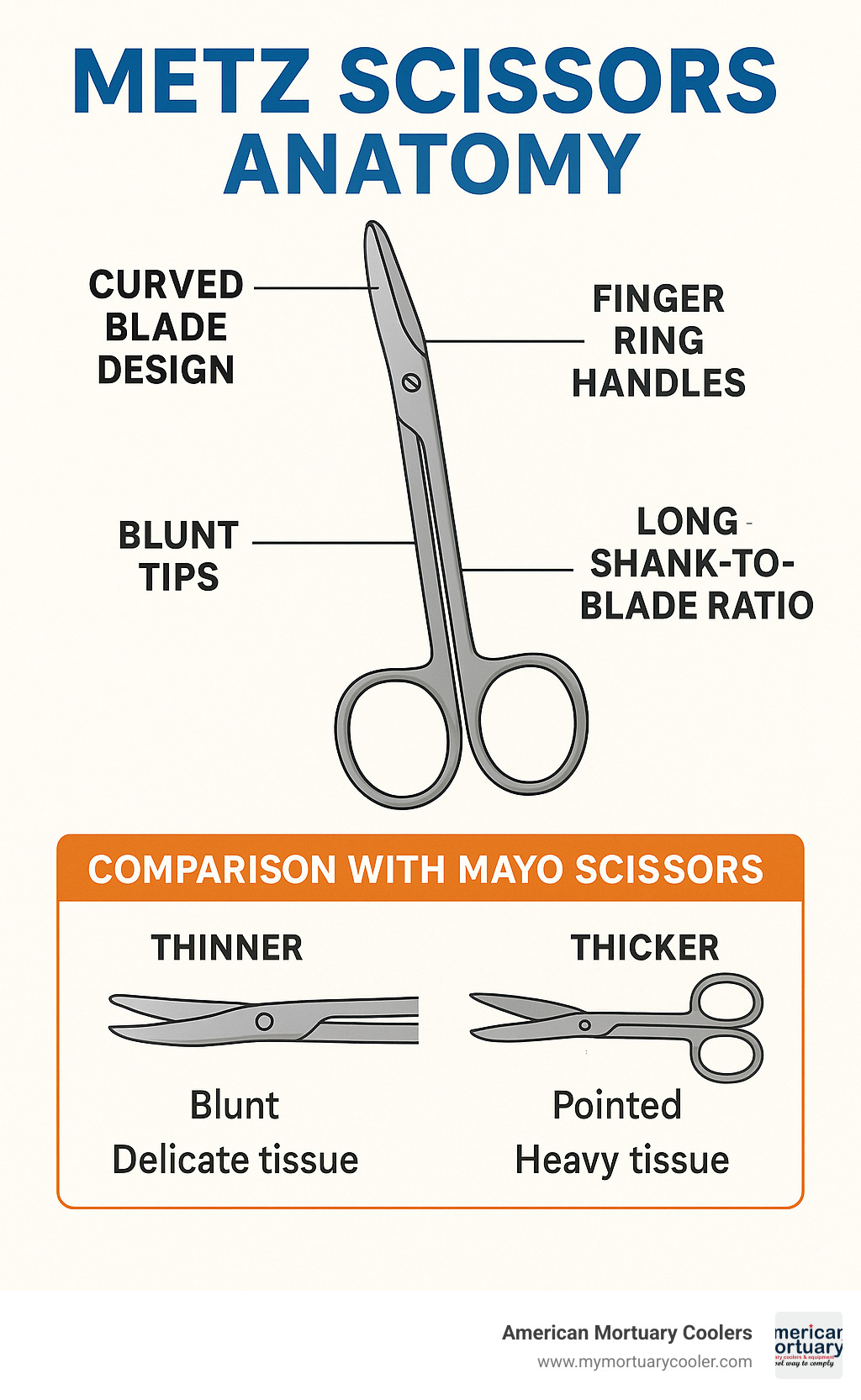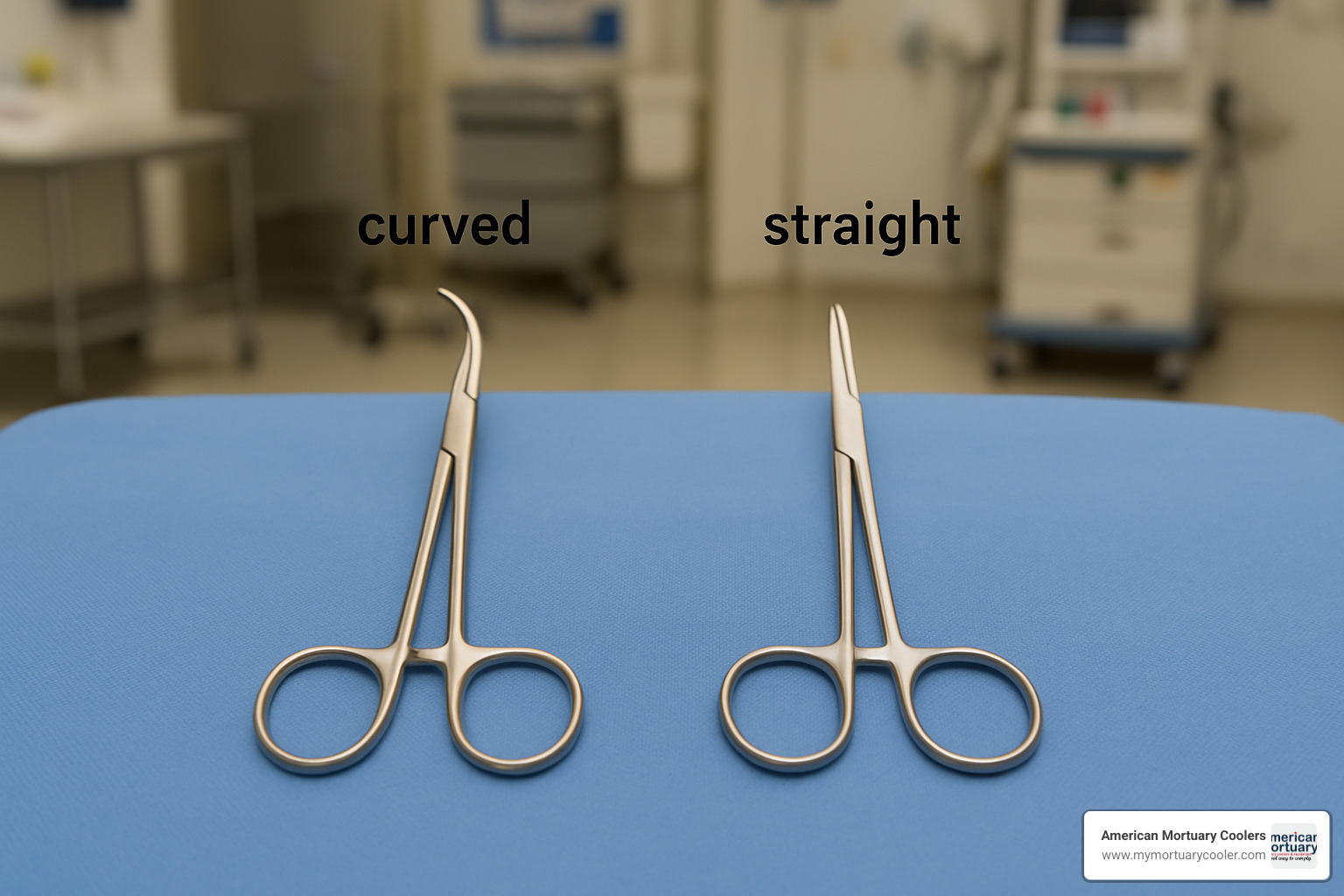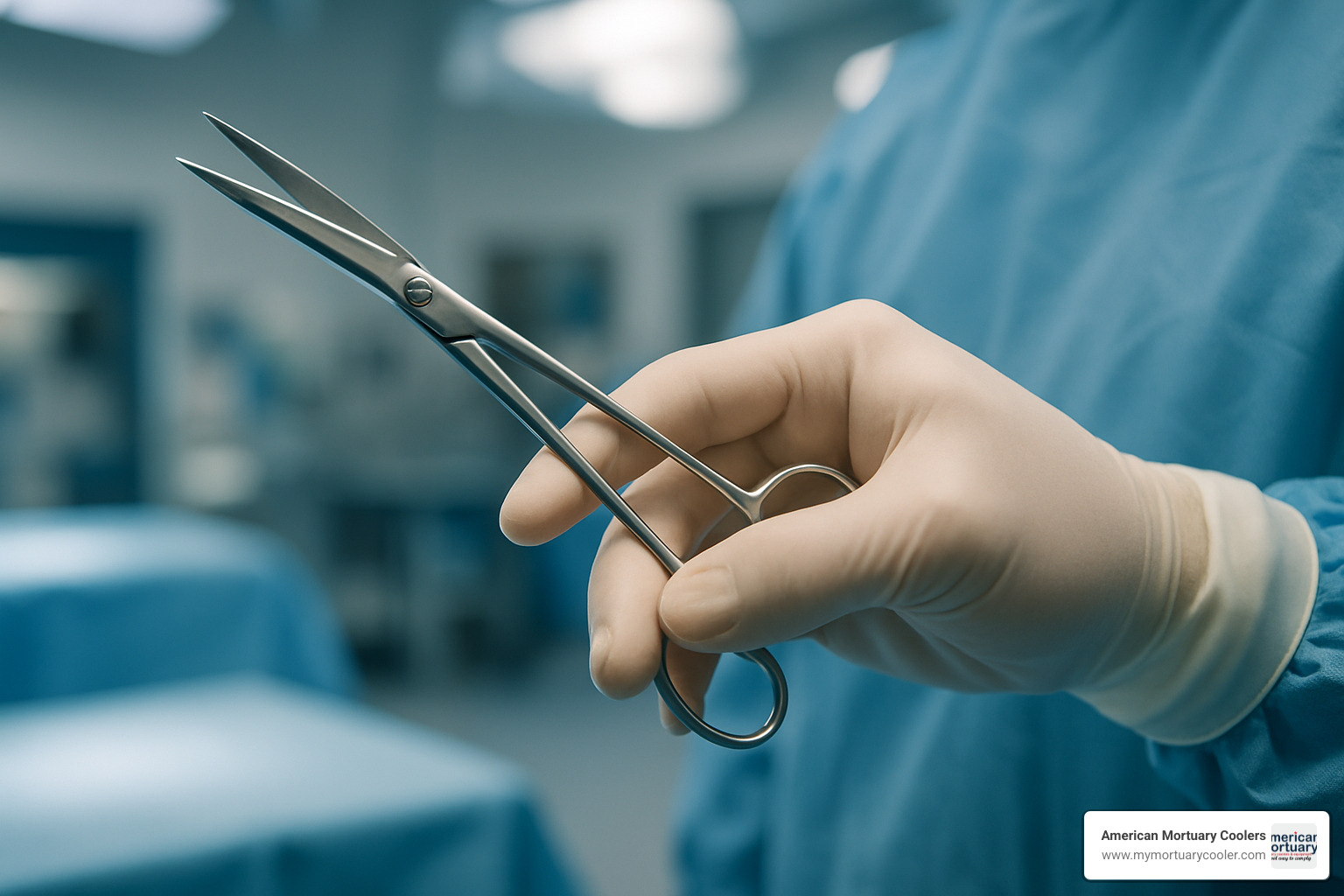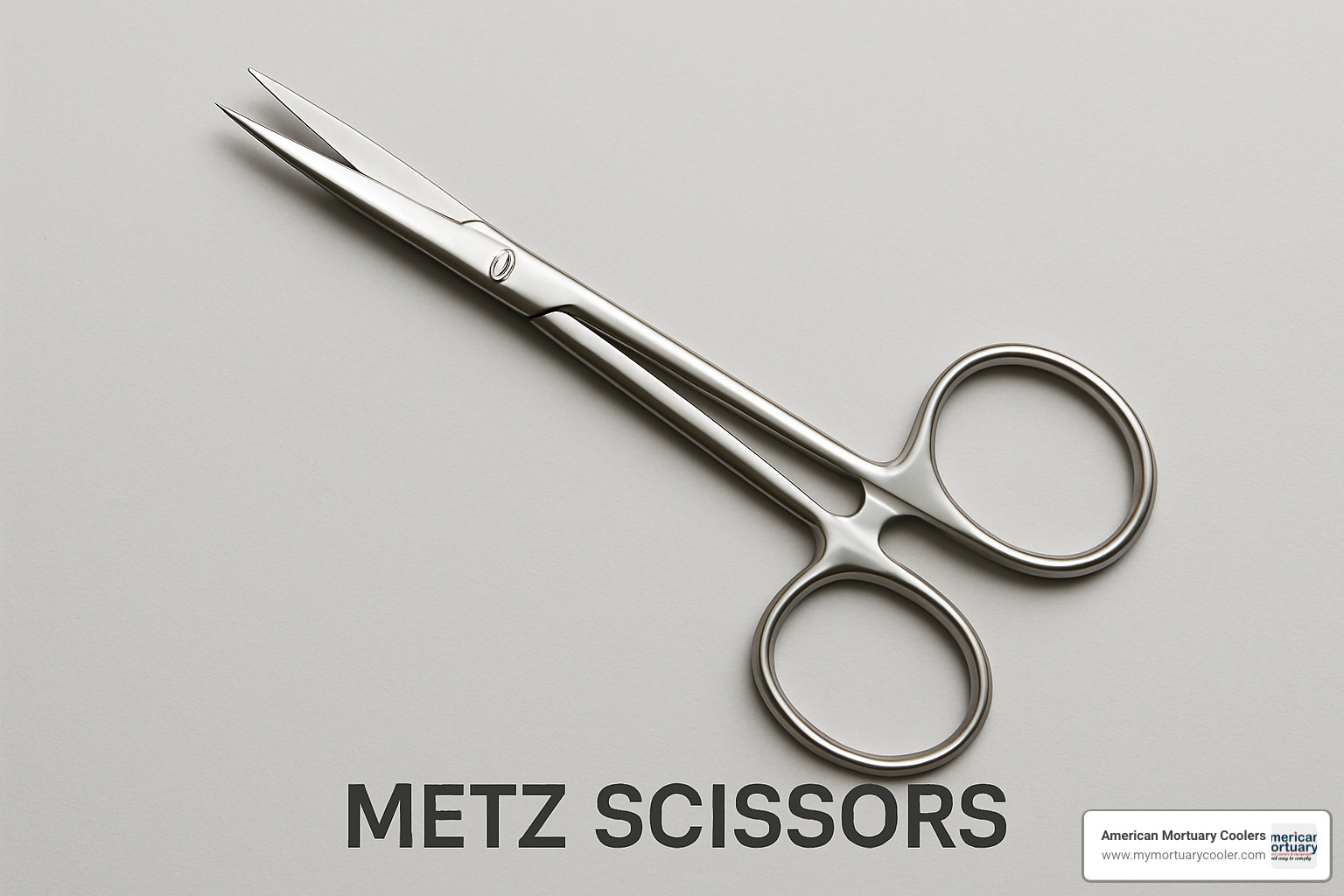
All About Metz Scissors: Types, Uses, and Where to Buy
Understanding Metz Scissors: The Precision Instruments Every Professional Needs
Metz scissors (short for Metzenbaum scissors) are specialized surgical instruments designed for cutting delicate tissue and performing blunt dissection. Here's what you need to know:
Quick Facts:
- Primary use: Cutting soft, delicate tissues during surgery
- Key feature: Long shank-to-blade ratio for precise control
- Tip design: Blunt tips to prevent accidental tissue damage
- Materials: Stainless steel with optional tungsten carbide inserts
- Size range: 4.5 to 14.5 inches in length
- Common types: Curved, straight, super-cut, and delicate variations
These precision instruments were invented by Dr. Myron F. Metzenbaum (1876-1944) and have become the most commonly used scissors in organ-related operations. Unlike heavier Mayo scissors, metz scissors excel at fine dissection work where control and precision matter most.
The key difference lies in their design: metz scissors feature a high shank-to-blade ratio that gives surgeons better leverage and control when working in deep cavities or around delicate structures. Their blunt tips help prevent accidental punctures, while the curved or straight blade options accommodate different surgical approaches.
Important: Metz scissors should never be used to cut sutures, drains, or heavy tissue - doing so will dull their fine edges and reduce their effectiveness for delicate work.
As professionals at American Mortuary Coolers, we've worked extensively with funeral home directors who need reliable, precision instruments for their operations, including understanding how metz scissors fit into the broader toolkit of professional-grade equipment. Our experience helping clients choose the right instruments has shown us how critical it is to select tools that match specific procedural needs.

What Are Metzenbaum (Metz) Scissors?
Metz scissors are precision surgical instruments designed specifically for delicate soft tissue dissection. These specialized scissors excel at separating and cutting through gentle tissues without causing unnecessary damage.
What makes these scissors special is their distinctive high shank-to-blade ratio - the handles are much longer compared to the cutting blades. This design gives surgeons incredible control and precision when working with tissues that need the gentlest touch possible.
The blunt tips are a brilliant safety feature. Instead of sharp, pointed ends that could accidentally puncture an organ or blood vessel, these scissors have rounded tips that allow surgeons to safely steer between tissue layers. This design makes them the go-to choice for organ-related surgeries - they're used more frequently than any other type of surgical scissors in these procedures.
Over 200 different patterns and variations of Metzenbaum scissors are available today, showing their adaptability across different surgical specialties.
History of Metz Scissors
Dr. Myron Firth Metzenbaum (1876-1944) was an American surgeon who recognized that existing scissors were either too heavy for delicate work or lacked the precision needed for fine dissection. Scientific research on Myron Metzenbaum reveals he was a respected pioneer who understood the daily challenges of operating room work.
As surgical procedures became more refined throughout the 20th century, his scissors became indispensable in operating rooms worldwide. Today, his name remains synonymous with precision surgical cutting, and his basic design principles remain largely unchanged.
Key Design Anatomy of Metz Scissors
Modern metz scissors are built from high-grade surgical stainless steel for durability, corrosion resistance, and edge retention. Premium models feature tungsten carbide inserts at the cutting edges for superior performance and extended lifespan.
The finger rings are ergonomically designed for different hand sizes and secure grip. Gold rings typically indicate tungsten carbide models, while silver rings denote standard stainless steel versions - a color system that helps surgical staff quickly identify the right instrument.
The length range of 4.5 to 14.5 inches provides flexibility for different procedures. Shorter scissors work for surface procedures and pediatric work, while longer models are designed for deep cavity work. The ergonomic shank design provides better leverage and control while reducing hand fatigue during lengthy procedures.
Types and Variations of Metz Scissors
Metz scissors come in numerous configurations, each designed for specific surgical challenges. Standard models serve as workhorses, while curved versions feature a gentle arc perfect for navigating around organs. Straight versions offer direct cutting action for linear procedures.
Delicate metz scissors take precision further with finer tips and thinner blades for microsurgery. Super-cut versions feature micro-serrations preventing tissue slippage, while left-handed models ensure southpaw surgeons have proper ergonomics.
Curved vs. Straight Metz Scissors

Curved metz scissors excel in deep cavity work. The gentle arc allows surgeons to follow natural body contours and reach around structures while maintaining good visualization. They're champions for abdominal and chest cavity procedures.
Straight metz scissors shine for direct, linear cutting action. They're particularly popular with plastic surgeons working with straight-line incisions and surface dissections. Most experienced surgeons keep both types available and switch based on anatomical needs.
SuperCut & Tungsten Carbide Options
SuperCut models feature micro-serrations on the lower blade that grip tissue, preventing slippage with difficult tissues. The real game-changer is tungsten carbide technology - those distinctive gold handles signal tungsten carbide inserts that stay sharp far longer than standard models.
More info about Metzembaum scissors provides additional details about these advanced options.
While tungsten carbide scissors cost more upfront, they often prove more economical long-term with 5-year warranties and significantly longer edge life.
Size and Specialty Choices
Metz scissors range from petite 4.5-inch models for pediatric procedures to hefty 14.5-inch versions for deep cavity work. Pediatric procedures typically use 4.5 to 7-inch sizes, while standard adult procedures rely on the 7 to 9-inch range. Bariatric surgery and deep cavity procedures often demand 11 to 14.5-inch models for adequate reach through thick tissue layers.
Metz Scissors vs Mayo Scissors: Choosing the Right Tool
Metz scissors and Mayo scissors serve different purposes in surgery. Metz scissors are precision instruments with long, slender blades and high shank-to-blade ratios - built for control and precision. Mayo scissors are workhorses with shorter, beefier blades that power through tough materials.
Metz scissors typically cost more than Mayo scissors, reflecting the precision engineering required for delicate work. Mayo scissors are built for durability and heavy use, while metz scissors need careful maintenance to preserve their precision edge.

When to Reach for Metz Scissors
Metz scissors are ideal when precision matters more than power. Cardiovascular surgery is where they truly shine - working around the heart or major blood vessels requires absolute control and blunt tips to prevent accidental damage.
Plastic surgery relies heavily on metz scissors for cosmetic results. Fine dissection capabilities help create perfect tissue planes, leading to better healing and minimal scarring. Veterinary professionals also use metz scissors extensively for small animal soft tissue work.
Scientific research on scissor handling shows proper instrument selection is crucial for surgical success.
When Mayo Scissors Win Out
Mayo scissors excel when you need cutting power and durability. Fascia cutting is Mayo scissors territory - this tough, fibrous tissue would quickly dull metz scissors. Suture cutting should never be done with metz scissors - this common mistake ruins expensive precision instruments.
Orthopedic procedures and OB-GYN work frequently involve tough tissues and multiple suture materials - perfect Mayo scissor applications. Save your metz scissors for the delicate work they were designed to handle.
Using Metz Scissors Safely: Best Practices and Maintenance
Proper metz scissors handling starts with correct grip: thumb in one ring, ring finger in the other, index finger resting on the screw head for stability. This grip provides maximum control and steady tip positioning.
Metz scissors are designed exclusively for cutting soft, delicate tissue. Using them for sutures, drapes, or letting them contact bone will ruin these precision instruments. When sharpening is needed, use professional services that understand surgical instrument requirements.
Sterilization follows standard protocols - autoclave at 134°C for appropriate cycle times.
Handling in the OR

The index finger on the screw head serves as your anchor point. During supination and pronation movements, this finger keeps the tip stable and controlled. Use stabilization techniques - rest your hand on the patient or surgical table when possible for better control.
Effective metz scissors technique accepts slow, steady movements. Never cut what you can't see clearly - both tissue and scissor tips should be in full view.
Cleaning & Sterilization
Pre-rinse immediately with cold water to prevent blood and tissue buildup. Enzymatic soaking breaks down proteins and organic matter - keep scissors open during soaking for complete solution penetration.
For autoclave sterilization, position scissors carefully to ensure steam penetration without instrument damage. Lubrication after sterilization with surgical instrument lubricants keeps joints moving smoothly.
More info about mortuary tools
Regular inspection should check blade alignment, smooth joint operation, sharp cutting edges, and signs of corrosion or damage.
Misuse to Avoid
Common mistakes that ruin metz scissors include: cutting drapes (synthetic materials dull precision edges), contact with bone (chips or dulls blades), dropping instruments (misaligns blades or damages joints), and over-tightening the screw (damages mechanism and reduces smooth operation).
Where to Buy Metz Scissors and Typical Price Ranges
Metz scissors are readily available from reputable online medical suppliers. A 5½-inch standard stainless steel model typically costs $118-$145, while 14½-inch versions run $230-$250. Tungsten carbide premium models cost about 20% more but often include longer warranties and extended service life.
Many suppliers offer bulk discounts for multiple instruments or complete sets. Warranty considerations are important - premium tungsten carbide models often include impressive 5-year warranties.

Trusted Medical Suppliers
Reliable sources for metz scissors include gSource, Black & Black, GerMedUSA, and JEDMED - all with solid reputations in medical instrument supply. Distributor networks provide faster delivery and additional services like instrument repair.
Avoid counterfeit instruments by sticking with established medical supply companies that verify product authenticity. Professional suppliers often provide value-added services like instrument tracking systems and maintenance programs.
Budgeting and Procurement Tips
The tungsten carbide versus stainless steel decision depends on practice volume - TC models cost more upfront but offer better long-term value for high-volume practices.
Always verify FDA/CE marks on surgical instruments. Check return policies and subscribe for sales alerts from trusted suppliers to take advantage of promotions and bulk pricing opportunities.
Frequently Asked Questions about Metz Scissors
Are metz scissors suitable for veterinary or dental procedures?
Metz scissors are excellent for veterinary medicine, particularly for delicate soft tissue work in small animals. They're commonly used for dental procedures, obstetrical and gynecological procedures, dermatological work, and ophthalmological veterinary procedures.
Veterinary use typically favors smaller models (5-7 inches) for small animal anatomy. The same rule applies: never use metz scissors to cut sutures, drains, or heavy tissue in veterinary applications.
How often should metz scissors be sharpened or replaced?
For standard stainless steel models in busy practices, sharpening is typically needed every 6-12 months. Tungsten carbide models can often go 2-3 years or longer between sharpenings.
Watch for signs like difficulty cutting tissue cleanly or crushing tissue instead of clean cuts. Always use professional sharpening services that understand surgical instrument requirements.
Replacement time comes when joints become loose, blades won't align properly, or repeated sharpenings have significantly reduced blade size.
Can metz scissors be used to cut sutures or heavy tissue?
No, absolutely not. Using metz scissors to cut sutures or heavy tissue will quickly dull the fine edges that provide precise control. Metz scissors are specifically designed for delicate tissue dissection only.
Mayo scissors are the correct choice for cutting sutures and heavy tissues. Keep both types available to use the right tool for each specific task - this approach maintains instrument quality and surgical precision.
Conclusion
Metz scissors represent surgical precision at its finest. From Dr. Myron Metzenbaum's innovative design to today's advanced tungsten carbide models, they continue setting the standard for delicate tissue work.
The key to success with metz scissors is understanding their focused purpose: precise, controlled cutting of delicate tissues. Choose curved models for deep cavity procedures and straight versions for surface work. Tungsten carbide options offer exceptional durability for high-volume practices.
Proper care makes all the difference. Follow correct sterilization procedures, avoid using them for cutting sutures or heavy tissue, and invest in professional sharpening when needed.
At American Mortuary Coolers, we specialize in crafting custom mortuary coolers and equipment for funeral homes across our service area from Tennessee to California. Just as we're committed to delivering durable, custom solutions for our clients in the funeral industry, we recognize that quality instruments like metz scissors represent that same dedication to excellence and reliability.
For professionals who work with precision instruments, our Essential Embalming Equipment guide offers valuable insights into soft-tissue instruments and other essential equipment for professional practice.
Whether you're performing cardiovascular surgery, plastic surgery procedures, or veterinary operations, investing in quality metz scissors and using them correctly will improve your ability to deliver precise, safe results. These instruments aren't just tools – they're partners in providing the best possible outcomes for those you serve.



